Your Time has Finished
Loading...
BMAT 2011-S1
Your Score: %
Average Score of All Users:
You performed better than of students
Section Breakdown
| Your Score | Average of all Users | Percentile | |
|---|---|---|---|
| BMAT 2011 S1 |
BMAT 2011 S1
Your score:
Average score:
You performed better than of students
This section is Section 1 of 3.
Speed as well as accuracy is important in this section. Work quickly, or you might not finish the paper. There are no penalties for incorrect responses, only marks for correct answers, so you should attempt all 35 questions. Each question is worth one mark.
You must complete the answers within the time limit. Calculators are NOT permitted.
Good Luck!
Note – if press “End Exam” you can access full worked solutions for all past paper questions
The weather forecast for a five day period is summarised in the table below:
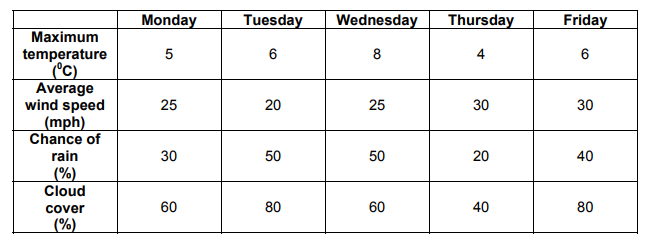
For each of the rows of the table one of the bar charts A to E could represent the data if it were suitably labelled.
Explanation
The correct answer is D.
For maximum temperature, Wed’s bar should be the tallest followed by Tue’s and Fri’s which will be the same height as each other. This is shown by graph E.
For average wind speed, Thu’s and Fri’s should be joint tallest, followed by Mon and Wed which are joint second tallest. This is shown by graph C.
For chance of rain, Tue and Wed should be joint tallest, followed by Fri. This is shown by graph B.
For cloud cover, Tue and Fri should be joint tallest, followed by Mon and Wed. This is shown by graph A.
Therefore the only bar chart that does not represent a row in the table is graph D.
The seas around the UK have become so noisy that whales are having to sing louder to make themselves heard above the din created by ships, wind farms and oil exploration. With whale numbers severely depleted, the ability to communicate over long distances could be key to their finding a mate. According to a study by marine biologists, around the coast of the UK whale song is now ten times louder than it was fifty years ago, and also higher pitched. Whales are trying to adapt to increased man made noise either by emitting much louder noises or by calling at higher frequencies. Their messages are getting simpler and repeated more often, like a person being forced to shout.
Explanation
The correct answer is E.
None of these conclusions provided summarise the main conclusion from the passage that ‘whales are trying to adapt to increased man made noise by either emitting much louder noises or by calling at higher frequencies.’
Statement A is incorrect because we cannot infer that whales will become extinct because of increased man made noise.
Statement B is incorrect because although wind farms contribute to a noisier sea around the UK, it is not the sole reason for increased noise pollution. Additionally, there is no mention how whales are having to sing louder or at higher frequencies because of it.
Statement C is also incorrect because of the word ‘able to adapt’ in the statement. There is no certainty that they will manage to adapt but rather the passage states that they are ‘trying to adapt’ to increased man made noise.
Statement D is incorrect because although whale numbers have become severely depleted it cannot be inferred that this depletion is due to increased growth of human noise.
I am planning to visit a resort for my holiday this summer. There are three options for my accommodation: a single room which costs $70 per night, a deluxe room which costs $80 per night or a suite which costs $95 per night. The prices include meals, but it is possible to opt out from the meals by paying $15 less per night. The resort offers a taxi service from the airport at a cost of $10. Alternatively, it is possible to hire a car at the airport which can be used for the whole stay. This option costs $5, plus an additional $5 per night.
I want to stay for six nights in a deluxe room, but I don’t want my meals included in the price that I pay. I also want to hire a car for the duration of the stay.
Explanation
The correct answer is C.
6 nights in the deluxe room opting out of meals would cost (80-15)x6=65×6=$390. Hiring a car for the 6 nights would cost 5+(5×6)=5+30=$35. So the total cost for the stay would be 390+35=$425.
When children are young they often play games. These games are useful as they teach children how to interact with each other. In recent years the growth of computer games has meant that now many children play most of their games on computers and across the internet. Thus the way in which children interact with each other has changed. When these children grow up they will need to work in jobs that require interaction with co-workers. The increased popularity of computer games is therefore going to mean that they are less likely to be able to function socially within their workplace.
Explanation
The correct answer is E.
P1: Children used to play games with each other.
P2: Nowadays, many children play most of their games on the computer.
P3: The children will grow up and do jobs that require interaction with co-workers.
C1: Children are going to be less likely to be able to function socially within their workplace.
There is a gap between P2 and C1 as the passage doesn’t clarify if playing more video games has reduced time spent playing games with each other. A,B,C are irrelevant.
The diagram below shows two perpendicular mirrors with a reflected tile on the faces of both mirrors.
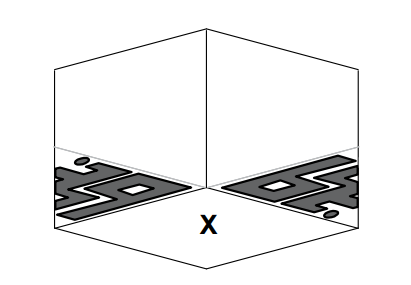
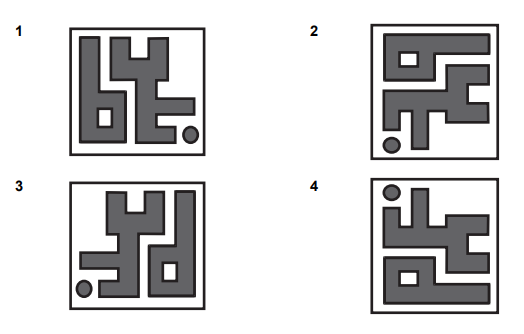
Explanation
The correct answer is F.
Tiles 1 and 2 are identical, and tiles 3 and 4 are identical. Therefore the answer must be 1 and 2 or 3 and 4, A or F. 1 and 2 can be superimposed on the reflections shown in the image, so they cannot be reflected in the perpendicular mirrors to give these reflections, so 3 and 4 must give the reflections when placed in position X.
Becoming a London taxi driver isn’t as easy as you may think. Unlike other London folk who choose to take the tube or bus, taxi drivers have to spend hours learning the city’s road network for a face-to-face exam at the Public Carriage Office to get a licence to start their careers. Recent brain scans on a group of taxi drivers revealed that areas of their brains associated with memory were more developed than would be normal for the general population. So all that learning not only makes them money, but also increases their memory power.
Explanation
The correct answer is C.
The conclusion is that being a taxi driver involves learning which increases their memory power.
This is based on the recent brain scans as supporting evidence. However, it could be that they were more intelligent preceding the role – so is it that they are able to remember things because they are taxi drivers or the other way around?
An airline has decided to introduce a flight from London, England to St. John’s, Antigua. The airline owns a range of aeroplanes as shown in the table below. It needs to decide which one would be best suited to do this flight. The distance travelled between London and St John’s is a maximum of 5600 miles; variability is due to different flight paths. A weekly flight would have between 163 and 177 passengers.
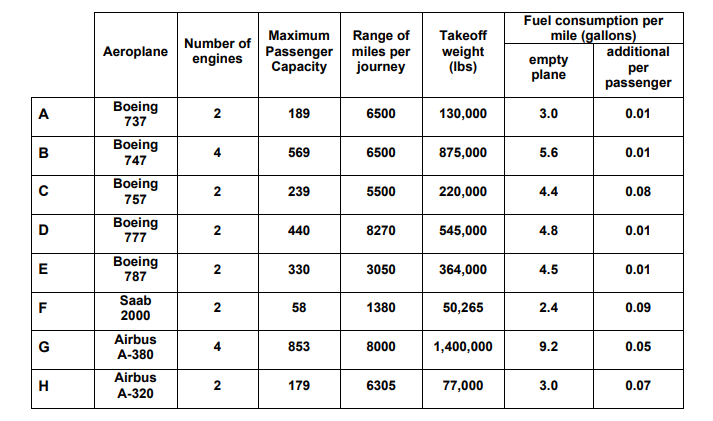
Explanation
The correct answer is A.
We can eliminate F because its maximum passenger capacity is less than what we want. We can also eliminate C and E because their range of miles per journey is less than 5600. Eliminate G because we can tell from its large fuel consumption when the plane is empty that it will not be the most fuel efficient plane. Similarly, eliminate H because its large fuel consumption per additional passenger suggests it also will not be the most fuel efficient. So we have options A, B and D remaining. Assuming an average of (163+177)/2=170 passengers, we can calculate the fule consumption for each of the remaining options:
A – 3+(0.01×170)=3+1.7=4.7 gallons per mile
B – we don’t need to calculate this because we can see that it will have a higher fuel consumption as it have the same increase in fuel consumption per additional passenger as A but a higher starting fuel consumption (for an empty plane)
D – similar to the explanation given above for B, we can see that D will have a higher fuel consumption than A without calculation
Therefore the most suitable plane would be A.
The difference between men’s and women’s pay is still at unacceptable levels, according to recent TUC research. It found that from the age of 18 – and throughout the rest of their working lives – women earn less than men.
In their 20s, the pay gap for full-timers is a modest 3.3%, but in their 30s women take home 11.2% less than men. And in their 40s – the peak age for discrimination – the gap rises to 22.8%
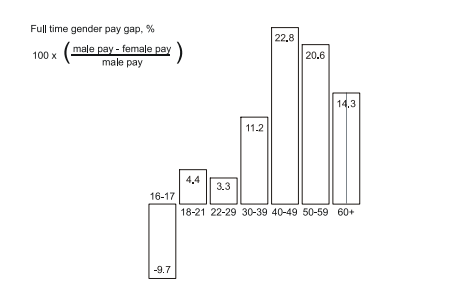
The TUC said the undervaluing of women in the workplace was partly due to a “motherhood penalty”. The long hours and intensity of senior positions deterred mothers from seeking promotions for which they were qualified. The TUC said there was direct discrimination against mothers and their choice became limited to jobs that could be combined with looking after children.
The “motherhood penalty” became even more severe for women who switched to part-time work. They were more likely to change employer or occupation, often taking jobs with lower hourly earnings. The hourly earnings of women working part-time were 23.4% less than the equivalent male rate in their 30s, and 41.2% in their 40s.
Explanation
The correct answer is D.
A cannot be concluded because the graph shows the gender pay gap peaks before the age of 50 on average but we do not know whether this is due to an average decrease in women’s earnings, increase in men’s earnings, or a combination of both.
B cannot be concluded because the limited job choice referred to alludes to mother and not specific age groups.
C cannot be concluded because the each bar on the graph represents an age range, not a specific age, so we do not know whether the percentage difference had trebeled between the age of 22 and 30 or 26 and 37 or 25 and 39, etc.
Therefore D can be reliably concluded, because from the graph we can see than from the age of 40 to 59 male pay is over 20% greater than female pay, so if a man was being paid £1, a woman would be expected to be paid less than 1×0.80=£0.80.
The difference between men’s and women’s pay is still at unacceptable levels, according to recent TUC research. It found that from the age of 18 – and throughout the rest of their working lives – women earn less than men.
In their 20s, the pay gap for full-timers is a modest 3.3%, but in their 30s women take home 11.2% less than men. And in their 40s – the peak age for discrimination – the gap rises to 22.8%

The TUC said the undervaluing of women in the workplace was partly due to a “motherhood penalty”. The long hours and intensity of senior positions deterred mothers from seeking promotions for which they were qualified. The TUC said there was direct discrimination against mothers and their choice became limited to jobs that could be combined with looking after children.
The “motherhood penalty” became even more severe for women who switched to part-time work. They were more likely to change employer or occupation, often taking jobs with lower hourly earnings. The hourly earnings of women working part-time were 23.4% less than the equivalent male rate in their 30s, and 41.2% in their 40s.
Explanation
The correct answer is C.
The full time gender pay gap in the age range 40-49 is 22.8%. Substituting know values into the equation given:
Full time gender pay gap =100x (male pay – female pay / male pay)
22.8=100x(male pay – 16000 / male pay
We can rearrange the equation to make ‘male pay’ the subject:
0.228= male pay – 16000 / male pay
0.228(male pay)=male pay-16000
16000=male pay-0.228(male pay)
16000=male pay(1-0.228)
16000=male pay(0.772)
Male pay=16000/0.772=£20700.
The difference between men’s and women’s pay is still at unacceptable levels, according to recent TUC research. It found that from the age of 18 – and throughout the rest of their working lives – women earn less than men.
In their 20s, the pay gap for full-timers is a modest 3.3%, but in their 30s women take home 11.2% less than men. And in their 40s – the peak age for discrimination – the gap rises to 22.8%

The TUC said the undervaluing of women in the workplace was partly due to a “motherhood penalty”. The long hours and intensity of senior positions deterred mothers from seeking promotions for which they were qualified. The TUC said there was direct discrimination against mothers and their choice became limited to jobs that could be combined with looking after children.
The “motherhood penalty” became even more severe for women who switched to part-time work. They were more likely to change employer or occupation, often taking jobs with lower hourly earnings. The hourly earnings of women working part-time were 23.4% less than the equivalent male rate in their 30s, and 41.2% in their 40s.
Explanation
The correct answer is C.
‘The TUC said the undervaluing of women in the workplace was partly due to a “motherhood penalty”.’ Therefore the answer is C.
The difference between men’s and women’s pay is still at unacceptable levels, according to recent TUC research. It found that from the age of 18 – and throughout the rest of their working lives – women earn less than men.
In their 20s, the pay gap for full-timers is a modest 3.3%, but in their 30s women take home 11.2% less than men. And in their 40s – the peak age for discrimination – the gap rises to 22.8%

The TUC said the undervaluing of women in the workplace was partly due to a “motherhood penalty”. The long hours and intensity of senior positions deterred mothers from seeking promotions for which they were qualified. The TUC said there was direct discrimination against mothers and their choice became limited to jobs that could be combined with looking after children.
The “motherhood penalty” became even more severe for women who switched to part-time work. They were more likely to change employer or occupation, often taking jobs with lower hourly earnings. The hourly earnings of women working part-time were 23.4% less than the equivalent male rate in their 30s, and 41.2% in their 40s.
Explanation
The correct answer is D.
Women aged 60+ on average earn 14.3% less than men. So for every £10 earned by a man a woman would earn 10x(1-0.143)=10×0.857= £8.57. But we have used figures from the full-time pay gap graph, and we can see from paragraph 4 that the gap may be greater for part-time pay for over 60s because it is greater for people in their 30s and 20s. So the data may support A but not strongly.
B cannot be concluded because the graph shows a percentage difference between male and female pay, so we do not know the contributions from each of male and female to pay these figures, so we cannot isolate facts about male pay.
C may be implied by a smaller pay gap in 20s compared to 30s, but again this percentage depends on both male and female pay and we dont know whether female pay has decreased going from 20s to 30s or male pay has increased or if it is due to a combination of both.
The graph shows that on average women earn 22.8% less than men in their 40s. But this graph is for full-time pay, so we can get a more accurate estimate using the 41.2% pay gap quoted in paragraph 4. For every £15 earned by man in his 40s working part-time, a woman would be expected to earn 15x(1-0.412)=15×0.588=£8.82. Therefore D is most supported by the text.
This is the floor of a room in my house, which is tiled with 81 tiles of the same size.
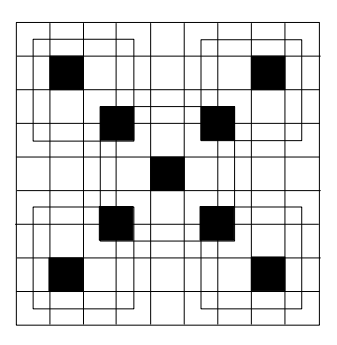
Explanation
The correct answer is D.
The 6 different tiles are highlighted in the image below:

The ability to use language (to communicate using symbols and words to represent objects, feelings and thoughts) separates humans from all other animals on earth. By the age of 18, humans know more than 60,000 words, which is a surprising figure when you consider the monosyllabic vocabulary used by most teenagers. From the age of six months babies begin to recognise their own language. There are genetic reasons why this form of communication is unique to humans. Humans and chimps actually share 99% of their DNA, but in 2006 researchers comparing the two species found a gene, HAR1, that makes us dramatically different. It is expressed in the human cerebral cortex, a part of the brain that is particularly associated with language.
Explanation
The correct answer is B.
The conclusion of the passage is that the gene HAR1, expressed in the human cerebral cortex, gives humans the ability to use language.
Statement B strengthens the argument because if a language specific impairment is caused by a mutation in the HAR1 gene, this then supports the argument that this gene gives humans the ability of language.
Statement A could to some extent weaken the argument, as the HAR1 gene is thought to be unique to humans. However, having a 98% similarity does not mean that the gene will therefore have the same function as they do in humans.
Statement C would weaken the main conclusion.
Statements D & E are irrelevant to the argument.
The final league table for the inter-regional cribbage competition is shown below (in alphabetical order). Five teams took part and all played each other once. The points system is 3 for a win, 1 for a draw and 0 for a loss. Unfortunately, the points for the Eastern Region team have been obliterated.
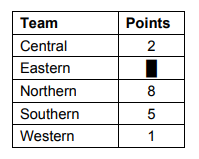
Explanation
The correct answer is C.
The score for central can only have been made by two draws and two losses. The score for Western could have only been made by one draw and three losses. Southern’s score is made up by one win, two draws and a loss. Northern would have won twice, and drawn twice. So far we have 3 wins, 7 draws and 6 losses altogether. We need 3 more wins (because the number of wins must be equal to the number of losses) and 1 draw (because in a single game both teams must draw, so the number of draws must be even). Therefore Eastern’s score must have been (3×3)+1=10.
The UK should not comply with the ruling by the European Court of Human Rights (ECHR) that prisoners should be allowed to vote in general and local elections. European member states are bound to respect human rights, and the ECHR is the organisation that defines those rights. However, although freedom and democracy are human rights, voting is not. It is a constitutional right, because it is conferred by nations that practise democracy. It is a fundamental aspect of the relationship between individuals and the state. Obedience to the law is also an aspect of this relationship. Thus it is entirely proper that the state should be free to decide that those who are imprisoned because they have broken the law should temporarily be deprived of their right to vote.
1. It assumes that individual states should define human rights.
2. It assumes that a constitutional right cannot be a human right.
3. It assumes that prisoners want to be allowed to vote in general elections.
Explanation
The correct answer is B.
The main conclusion of the passage is that those who have been imprisoned should temporarily not have the right to vote. The passage assumes that something cannot be both a constitutional and a human right, but rather that it has to be one or the other. Therefore, statement 2 if considered true, is correct.
Statement 1 is incorrect because the passage does not discuss who defines human rights.
Statement 3 is incorrect because there is no mention of the prisoners wanting to be allowed to vote in general elections.
Data for the world’s largest 10 lakes are shown below:
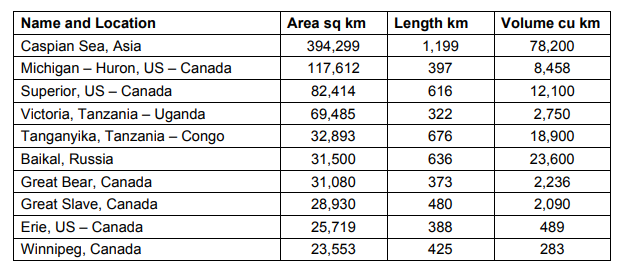
Explanation
The correct answer is D.
Volume= lengthxwidthxdepth. Area=lengthxwidth. So dividing the volume by the area should give the depth. We only need to consider which has the greatest depth out of the options A-E given.
Caspian sea – 78000/394000=0.20
Victoria – 2800/69500=0.040
Tanganyika – 18900/32900=0.57
Baikal – 23600/31500=0.75
Winnipeg – 300/23500=0.013.
Therefore the answer is Baikal, D. But we did not have to carry out all of these calculations because by inspection of the data in the table we can see that all of the figure for volume are greater than for area, but the volume of Baikal is closest to its area because it is the only volume that has the same number of digits as the figure for its area.
The brain disease vCJD was caused by eating beef from cattle infected with BSE. Susceptibility to this type of disease amongst humans is associated with a particular gene. There are two variants of this gene – M and V, so there are three possible combinations that we can inherit – M-M, M-V and V-V. All infections so far in the UK have been in young people with the M-M combination. Most victims of a similar disease in Papua New Guinea also had the M-M combination and were also young, but a group who developed it later in life all had the M-V combination. Therefore the gene variants one inherits determine the incubation period for such diseases. So there will be two further outbreaks of vCJD, as those who consumed infected beef grow older.
1. Most of the population have eaten beef infected with BSE.
2. Inheriting the V variant prevents infection with vCJD.
3. Inheriting the M variant is not necessary for susceptibility to vCJD.
Explanation
The correct answer is C.
The passage is assuming that the combination of genes is the most important factor and the M variant is not as important.
Statement 1 isn’t needed for the argument to hold as the main conclusion is that there will be further outbreaks in the future as those who consumed infected beef grow older
Statement 2 is false as the argument says the V variant can cause vCJD in the future
Employees at Grindstone Ltd are paid a weekly wage according to the following formula: £240 + £5 for every year of their age above 21 (where appropriate) + £20 for every full year of service with the company.
Jasper is 43 years old and has worked for Grindstone for 6 years. Although Ruby is 8 years younger, she earns £40 per week more than Jasper.
Explanation
The correct answer is B.
Jasper’s pay can be calculated as: 240+5(43-21)+6(20)=240+5(22)+120=240+110+120=£470 a week.
Ruby’s pay can be calculated as: 240+5(43-8-21)+20R=240+5(14)+20R=240+70+20R=310+20R. Where R=the number of years Ruby has been employed by the company.
Because Ruby earns £40 more per week than Jasper, we can write:
470+40=310+20R
510=310+20R
200=20R
R=10.
So Ruby has been employed there for 10 years.
Therefore she has been employed there for 10-6=4 years longer than Jasper.
Tree diagrams are used in decision making by predicting the various possible outcomes and their likelihood. The diagram below represents the choices facing an oil company – call it ‘X-Oil’ – who have discovered a possible oil deposit and are deciding whether or not to drill at the site. They will make the decision on purely financial terms – i.e. likely profits or losses.
The key factors are the known drilling costs ($800,000) and the unknown returns, which depend on how big the oil strike is. A ‘small’ oil strike, worth only $80,000, would mean a net loss of $720,000 when drilling costs are factored in. But there is only a small chance of this, 0.1 or 10%. There is an equally small (10%) chance of a big and very profitable strike, approaching $5 million. The most likely outcome is a medium strike.
If the company decides not to drill, there is a 20% chance of finding a buyer for the drilling rights at $1 million, and a 60% chance of a buyer at $500,000.
To assist the decision whether to drill or not, each of the possible outcomes is assessed by multiplying the chance (probability) of each outcome by the potential profit or loss. If the sum of the possible outcomes (profit x chance) of a decision to drill is greater than the sum of outcomes of a decision not to drill, statistically the better option is to drill.
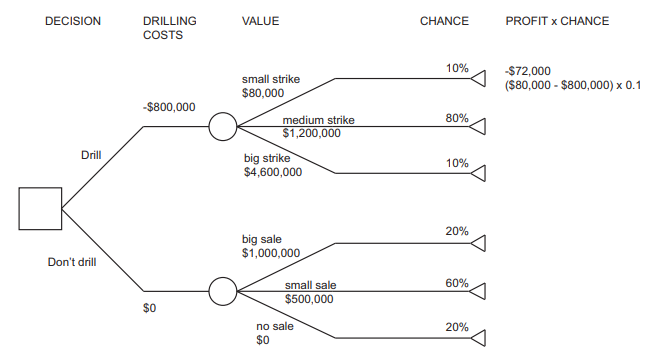
Explanation
The correct answer is A.
The total value of profitxchance for drilling is greater than for not drilling, therefore A can be concluded.
B cannot be concluded because A can, and B is the converse of A.
Similar to B, because we have determined that A is correct, C cannot be.
D is incorrect as selling the drilling rights for $500000 would give a smaller profit than a big strike.
E is incorrect not drilling could make a profit or no profit, but could not incur a loss.
Tree diagrams are used in decision making by predicting the various possible outcomes and their likelihood. The diagram below represents the choices facing an oil company – call it ‘X-Oil’ – who have discovered a possible oil deposit and are deciding whether or not to drill at the site. They will make the decision on purely financial terms – i.e. likely profits or losses.
The key factors are the known drilling costs ($800,000) and the unknown returns, which depend on how big the oil strike is. A ‘small’ oil strike, worth only $80,000, would mean a net loss of $720,000 when drilling costs are factored in. But there is only a small chance of this, 0.1 or 10%. There is an equally small (10%) chance of a big and very profitable strike, approaching $5 million. The most likely outcome is a medium strike.
If the company decides not to drill, there is a 20% chance of finding a buyer for the drilling rights at $1 million, and a 60% chance of a buyer at $500,000.
To assist the decision whether to drill or not, each of the possible outcomes is assessed by multiplying the chance (probability) of each outcome by the potential profit or loss. If the sum of the possible outcomes (profit x chance) of a decision to drill is greater than the sum of outcomes of a decision not to drill, statistically the better option is to drill.

Explanation
The correct answer is D.
A cannot be inferred because a medium strike would also be likely to make a profit according to the tree.
A medium strike would give a profit of 1200000-800000=$400000, whereas a sale of drilling rights would give a profit of between $500000 and $1000000. Therefore the sale would give a better outcome in any case, so B is incorrect.
Given that they choose to drill, there is a 10% chance of making a loss (via a small strike) and a 10+80=90% chance of making a profit (via a medium or large strike). Therefore the chance of making a profit by drilling is greater than the chance of making a loss, so C is incorrect.
The probability of a medium strike is 80% and the probability of selling the drilling rights at $500000 or more is the probability of a small sale plus the probability of a large sale 60+20=80%. Therefore D is correct.
Tree diagrams are used in decision making by predicting the various possible outcomes and their likelihood. The diagram below represents the choices facing an oil company – call it ‘X-Oil’ – who have discovered a possible oil deposit and are deciding whether or not to drill at the site. They will make the decision on purely financial terms – i.e. likely profits or losses.
The key factors are the known drilling costs ($800,000) and the unknown returns, which depend on how big the oil strike is. A ‘small’ oil strike, worth only $80,000, would mean a net loss of $720,000 when drilling costs are factored in. But there is only a small chance of this, 0.1 or 10%. There is an equally small (10%) chance of a big and very profitable strike, approaching $5 million. The most likely outcome is a medium strike.
If the company decides not to drill, there is a 20% chance of finding a buyer for the drilling rights at $1 million, and a 60% chance of a buyer at $500,000.
To assist the decision whether to drill or not, each of the possible outcomes is assessed by multiplying the chance (probability) of each outcome by the potential profit or loss. If the sum of the possible outcomes (profit x chance) of a decision to drill is greater than the sum of outcomes of a decision not to drill, statistically the better option is to drill.

1 Given the estimated costs, Y-Oil would not make a profit if there was only a ‘medium’ strike.
2 Given the estimated costs, the chances of Y-Oil making a profit are less than 80%.
3 Y-Oil could make a profit from a ‘medium’ strike if they could reduce drilling costs by 25%.
Explanation
The correct answer is F.
If there was a medium strike, they would gain $1200000, but lose $800000 in drilling costs in addition to the $500000 used to buy drilling rights, so overall this means 1200000-(800000+500000)=-$100000= a $100000 loss. So statement 1 is correct.
The only option, given that they have decided to drill, that would make Y-oil a profit is a big strike, which has a 10% chance, so statement 2 is also correct.
If drilling costs were reduced by 25% they would cost 800000×0.75=$600000. So from a medium strike they would incur 1200000-(600000+500000)=$100000 profit. So statement 3 is also correct.
Therefore all 3 statements are true.
Tree diagrams are used in decision making by predicting the various possible outcomes and their likelihood. The diagram below represents the choices facing an oil company – call it ‘X-Oil’ – who have discovered a possible oil deposit and are deciding whether or not to drill at the site. They will make the decision on purely financial terms – i.e. likely profits or losses.
The key factors are the known drilling costs ($800,000) and the unknown returns, which depend on how big the oil strike is. A ‘small’ oil strike, worth only $80,000, would mean a net loss of $720,000 when drilling costs are factored in. But there is only a small chance of this, 0.1 or 10%. There is an equally small (10%) chance of a big and very profitable strike, approaching $5 million. The most likely outcome is a medium strike.
If the company decides not to drill, there is a 20% chance of finding a buyer for the drilling rights at $1 million, and a 60% chance of a buyer at $500,000.
To assist the decision whether to drill or not, each of the possible outcomes is assessed by multiplying the chance (probability) of each outcome by the potential profit or loss. If the sum of the possible outcomes (profit x chance) of a decision to drill is greater than the sum of outcomes of a decision not to drill, statistically the better option is to drill.

Health and Safety advisors have warned that an accidental oil-spill at the site during drilling, resulting in compensation of up to $10,000,000, has a probability of 0.03 of occurring during a drill of the kind proposed. Insurance premiums against such an incident would cost the company $200,000.
X-Oil should:
1 pay the insurance and proceed with the drilling.
2 proceed with the drilling without insurance.
3 decide against drilling.
Explanation
The correct answer is E.
For option 1 the overall profitxchance would be: -200000-800000+(80000×0.10)+(1200000×0.80)+(4600000×0.10)=$428000
For option 2 we can see that the overall profitxchance would be less than option 1, so we do not need to calculate it.
For option 3 the overall profitxchance would be: (1000000×0.20)+(500000×0.60)=$500000
Therefore option 3 is the most favourable and option 2 is the least favourable.
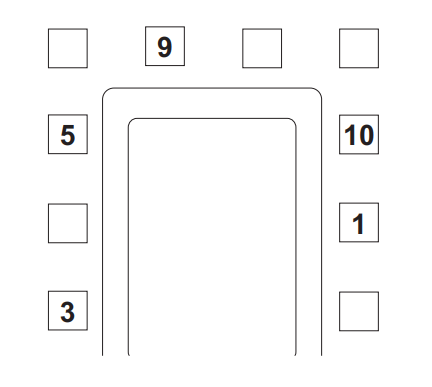
There are ten houses on Horseshoe Road, situated as shown above. They are numbered from 1 to 10, but not conventionally, and the numbers are missing on five of them. However, it is known that wherever four houses lie along a straight line, the four house numbers add up to 21.
Explanation
The correct answer is D.
The arrangement would be as shown below:

So number 7 is between 3 and 5.
 annabella
Medicmind Tutor
annabella
Medicmind Tutor
Wed, 10 Aug 2022 15:10:40
?? why
Asked at a press conference whether the new signing, Petermass, would be playing in the big match on Saturday, the Manager replied: “Only if Fredericks isn’t fit.”
Three of the journalists present noted the announcement as follows:
Jed wrote: “If Fredericks is fit Petermass won’t be playing.”
Ned wrote: “If Fredericks isn’t fit, Petermass will be playing.”
Ted wrote: “If Petermass doesn’t play it’ll mean Fredericks is fit.”
Explanation
The correct answer is A.
The manager’s and Jed’s statements are equivalent. But if Frederick’s isn’t fit, it does not mean that Petermass is definitely playing, therefore Ned’s statement is incorrect. Ted’s statement is also incorrect, because there may be a different reason for Petermass not playing. Therefore only Jed got the manager’s statement right.
Raymond has made up two vinaigrettes for his restaurant. One has half oil and half vinegar, the other has 2/3 oil and 1/3 vinegar. He has 180ml of each.
He wants to use them to make 2 x 180ml, each containing the same proportions, so he removes 90ml from the one with equal proportions and adds it to the other. He mixes well and takes 90ml from the new larger mix and adds it to the small one, so he once again has 2 x 180ml.
Explanation
The correct answer is C.
Let’s call the vinaigrettes 1 and 2. 1 has 180×0.5=90ml of oil and 90ml of vinegar initially. 2 has 180×2/3=120ml of oil and 180-120=60ml of vinegar initially.
He removes 90ml from 1 (containing 45ml of each of oil and vinegar) and adds it to 2. So 1 now contains 45ml of oil and 45ml of vinegar, and 2 contains 120+45=165ml of oil and 60+45=105ml of vinegar, with a total volume of 165+105=270ml. So the proportions of oil and vinegar in 2 are now 165/270=55/90 and 105/270=35/90.
He then takes 90ml (containing 55ml of oil and 35ml of vinegar) from 2 and adds it to 1. So 1 now contains 45+55=100ml of oil and 45+35=80ml of vinegar. 2 now contains 165-55=110ml of oil and 105-35=70ml of vinegar.
Therefore 1 has 100ml of oil and 2 has 110ml of oil.
A rocky planet, whose mass is three times that of Earth’s, could be the first ever to be found outside our solar system with the potential to support human life. Lying in the ‘Goldilocks Zone’ of the Milky Way, twenty light years away, the planet is said to have gravity similar to Earth and could well be capable of supporting life. The ‘Goldilocks Zone’ is a region in space where surface temperatures are neither too hot nor too cold for liquid water to form oceans, lakes and rivers. The fact that we were able to detect this planet so quickly and so nearby tells us that planets like this must be really common. The number of systems with potentially habitable planets is probably in the order of 10 or 20 per cent, and when you multiply that by the hundreds of billions of stars in the Milky Way, that’s a large number. There could be tens of billions of these systems in our galaxy.
Explanation
The correct answer is C.
The main conclusion in the passage is summarised in the highlighted sentences whereby the discovered ‘Goldilocks Zone’ with features similar to earth has the potential of supporting life. It then concludes that because this planet was detected so quickly and nearby to earth, that other such planets must be very common. This is summarised in statement C.
Statement A is incorrect because it is not the main conclusion but rather evidence to the conclusion, whereby gravity similar to that on Earth is a key feature to support life.
Statement B is also incorrect because although the ‘Goldilocks Zone’ is a region where water can form, it is not explicitly mentioned that this feature ‘must’ exist in order to support human life.
Statement D & E are both pieces of evidence presented in the passage rather than the overarching main conclusion.
I want to create a simple jigsaw puzzle. I have five pieces as shown below. Each piece is made from four identical squares. I want to choose three of the pieces to make up either a 4×3 rectangle or a 6×2 rectangle.

Explanation
The correct answer is A.
There are no combinations of 3 pieces which can make either rectangle of the dimensions given.
It has been celebrated recently that hydrogen fuelled buses are being introduced into London. This is because the use of hydrogen as a fuel is better for the environment as there are no emissions of carbon dioxide. The new buses carry the same number of passengers and will be travelling exactly the same routes as the ones that they are replacing. However, commercially sold hydrogen is produced from natural gas. The process to produce one tonne of hydrogen from natural gas puts, on average, eight tonnes of carbon dioxide into the atmosphere, whereas the production of fuel for the existing buses does not emit any carbon dioxide. The further costs of transporting the fuel to the bus depot also need to be considered. We should therefore not welcome the introduction of these buses.
Given that the following extra information is available:
1 The distance that each type of bus can travel using one tonne of fuel.
2 The distance that each bus needs to travel every week.
3 The amount of carbon dioxide emitted when the existing buses use one tonne of fuel.
4 For each type of fuel, the amount of carbon dioxide emitted in transporting one tonne of fuel to the bus depot.
Explanation
The correct answer is C.
Statement 1: This will allow us to evaluate the relative efficiency of the two types of buses.
Statement 2: As they are using the same routes, we know that the same amount of distance will be travelled by both.
Statement 3: Again, this will allow us to compare relative efficiency and therefore whether the argument is flawed.
Statement 4: This information will let us evaluate the efficiency of transportation the fuel.
Claire walks to work at 6km/hr and Charles cycles along the same route. Normally Charles overtakes Claire outside the public library. One day Claire leaves 20 minutes late and Charles overtakes her outside the swimming pool, 3km before she gets to the library.
Explanation
The correct answer is D.
20 minutes = 20/60=1/3hrs. Claire leaves 1/3hr late, but she is overtaken 3/6=1/2hr before her usual spot. Therefore it must take Charles ½-⅓=1/6hrs to cycle 3km, so his speed would be 3/(⅙)=3×6=18km/h.
 joy dhar
Medicmind Tutor
joy dhar
Medicmind Tutor
Tue, 06 Feb 2024 21:39:19
how did you know that she was overtaken 1/2 hr before her usual spot
A neutrino is an elementary particle that is able to pass through ordinary matter, but is difficult to detect. Physicists have hypothesised that there is a particular type of neutrino – a sterile neutrino – that cannot be detected at all by their instruments. Relevant evidence comes from supernovae, i.e. exploding stars. If sterile neutrinos did exist, supernovae would shoot them out, and the recoil from this blast would send pulsars (rotating stars that emit a beam of electromagnetic radiation) travelling at high speed through the universe. It turns out that astronomers observe precisely that: pulsars whizzing through the universe at speeds of thousands of kilometres per second.
Explanation
The correct answer is B.
Statement B is correct here and is summarised by the last two sentences whereby ‘pulsars whizzing through the universe’, given ‘if sterile neutrinos did exist’.
Statement A is incorrect because of the use of the word ‘must’. The passage does not certainly state that these sterile neutrinos are definitely the cause of the pulsars.
Statement C is incorrect because there is no mention of another hypothesis of the pulsars and how the sterile neutrinos being the best hypothesis.
Statement D is incorrect because the passage does not certainly state that these pulsars are due to the sterile neutrinos. Therefore, it cannot be deduced that these pulsars would not exist given that sterile neutrinos did not exist.
An exhibition of the work of a modern artist is currently on display at an art gallery for a period of 30 days. One of the exhibits, entitled “Countdown”, started off as 30 individual identical cylinders arranged in 10 stacks of 3, with the following appearance when viewed from above.
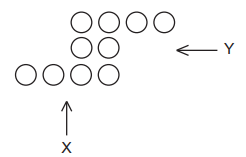
Each day since the exhibition began, one cylinder has been removed, and this will continue until there is just one left on day 30.
Today is day 11, so 20 cylinders remain. The view from above is still the same as it was on day 1, but the side view today from the direction marked X is:
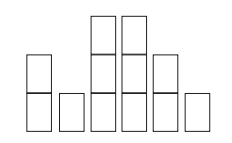
Explanation
The correct answer is C.
 liliananananana
Medicmind Tutor
liliananananana
Medicmind Tutor
Wed, 10 Aug 2022 15:40:01
wwwwwwwwwwwwwwwwwwwwwwh ere are the answersa
The graph below shows the results of surveys of local medical practices on number of patient consultations in 1995 and 2006. Consultations include face-to-face meetings with both doctors and nurses, telephone consultations and home visits.
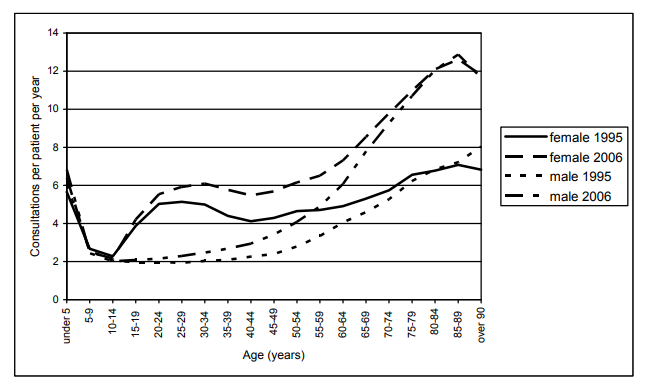
The overall mean consultation rate (per patient per year) was 3.90 in 1995 and 5.26 in 2006.
Findings for all years in the survey are shown below:

The consultation rate for doctors remained almost constant over the study period with 3.0 consultations per patient-year in 1995 and 3.3 in 2006. The consultation rate for nurses increased from 0.8 consultations per patient-year in 1995 to 1.8 in 2006. The consultation rate for other clinicians increased from 0.1 consultations per patient-year in 1995 to 0.2 in 2006.
Explanation
The correct answer is C.
In 2006, there were on average 1500×5.26=7890 consultations per doctor per year. If there are 250 days a year for a consultant then the number of consultations per doctor per day would be 7890/250=31.56=32.
The graph below shows the results of surveys of local medical practices on number of patient consultations in 1995 and 2006. Consultations include face-to-face meetings with both doctors and nurses, telephone consultations and home visits.

The overall mean consultation rate (per patient per year) was 3.90 in 1995 and 5.26 in 2006.
Findings for all years in the survey are shown below:

The consultation rate for doctors remained almost constant over the study period with 3.0 consultations per patient-year in 1995 and 3.3 in 2006. The consultation rate for nurses increased from 0.8 consultations per patient-year in 1995 to 1.8 in 2006. The consultation rate for other clinicians increased from 0.1 consultations per patient-year in 1995 to 0.2 in 2006.
Explanation
The correct answer is D.
‘The consultation rate for nurses increased from 0.8 consultations per patient-year in 1995 to 1.8 in 2006.’ The consultation rate per person per year given in the table is 3.90 for 1995 and 5.26 for 2006. The answer is calculated as follows:
![]() =67%.
=67%.
The graph below shows the results of surveys of local medical practices on number of patient consultations in 1995 and 2006. Consultations include face-to-face meetings with both doctors and nurses, telephone consultations and home visits.

The overall mean consultation rate (per patient per year) was 3.90 in 1995 and 5.26 in 2006.
Findings for all years in the survey are shown below:

The consultation rate for doctors remained almost constant over the study period with 3.0 consultations per patient-year in 1995 and 3.3 in 2006. The consultation rate for nurses increased from 0.8 consultations per patient-year in 1995 to 1.8 in 2006. The consultation rate for other clinicians increased from 0.1 consultations per patient-year in 1995 to 0.2 in 2006.
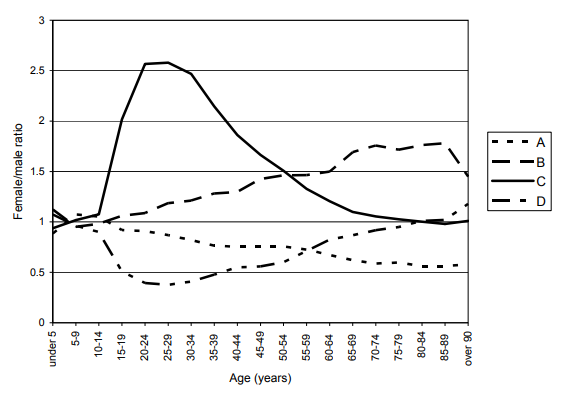
Explanation
The correct answer is C.
The largest gap between the lines representing male and female consultants in 2006 on the graph of consultations per patient per year against age is around the 20-24 ages category. That means that on the graph of female/male ratio against age the highest point of the graph should be reached in the same age range. The line which shows a peak at age 20-24 is C.
The graph below shows the results of surveys of local medical practices on number of patient consultations in 1995 and 2006. Consultations include face-to-face meetings with both doctors and nurses, telephone consultations and home visits.

The overall mean consultation rate (per patient per year) was 3.90 in 1995 and 5.26 in 2006.
Findings for all years in the survey are shown below:

The consultation rate for doctors remained almost constant over the study period with 3.0 consultations per patient-year in 1995 and 3.3 in 2006. The consultation rate for nurses increased from 0.8 consultations per patient-year in 1995 to 1.8 in 2006. The consultation rate for other clinicians increased from 0.1 consultations per patient-year in 1995 to 0.2 in 2006.
There has been a percentage increase in consultations between 1995 and 2006 for both sexes and all age groups.
Explanation
The correct answer is C.
C is the least satisfactory explanation because it is stated in the question that the percentage increase in consultations is for all age groups, so it would not matter that people have become 11 years older.
BMAT 2011 S1 Review Screen
Instructions
Below is a summary of your answers. You can review your questions in three (3) different ways.
The buttons in the lower right-hand corner correspond to these choices:
1. Review all of your questions and answers.
2. Review questions that are incomplete.
3. Review questions that are flagged for review. (Click the 'flag' icon to change the flag for review status.)
You may also click on a question number to link directly to its location in the exam.
BMAT 2011 S1 Section
Final Answer Review Screen
Instructions
This review section allows you to view the answers you made and see whether they were correct or not. Each question accessed from this screen has an 'Explain Answer' button in the top left hand side. By clicking on this you will obtain an explanation as to the correct answer.
At the bottom of this screen you can choose to 'Review All' answers, 'Review Incorrect' answers or 'Review Flagged' answers. Alternatively you can go to specific questions by opening up any of the sub-tests below.
BMAT 2011 S1 Section
TI-108
Let's get acquainted ?
What is your name?
Nice to meet you, {{name}}!
What is your preferred e-mail address?
Nice to meet you, {{name}}!
What is your preferred phone number?
What is your preferred phone number?
Just to check, what are you interested in?
When should we call you?
What time works best for you? (UK Time)
How many hours of 1-1 tutoring are you looking for?
My WhatsApp number is...
For our safeguarding policy, please confirm...
For our safeguarding policy, please confirm...
Which online course are you interested in?
What is your query?
SubmitYou can apply for a bursary by clicking this link
https://www.medicmind.co.uk/medic-mind-foundation/Sure, what is your query?
SubmitLoading...
Thank you for your response.
We will aim to get back to you within 12-24 hours.
Lock in a 2 Hour 1-1 Tutoring Lesson Now
If you're ready and keen to get started click the button below to book your first 2 hour 1-1 tutoring lesson with us. Connect with a tutor from a university of your choice in minutes. (Use FAST5 to get 5% Off!)
Buy Now for £70